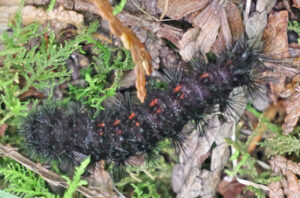Note: All links below go to external sites.
Greetings, BugFans,
Years ago, the BugLady photographed a Giant Leopard moth. It was a tough shot – the moth was tucked up under the eaves of a house. It’s – OK — but she wants another shot at it, and she also wants to photograph its very classy caterpillar. She fantasizes that when she does find one, the pictures will turn out better than her first attempt (one last amazing Leopard moth picture.
Anyway, when she saw this Agreeable tiger moth caterpillar, she thought maybe it was a Giant Leopard moth, but it lacked the Giant Leopard moth’s scarlet bands around the segments (intersegmental rings).
Agreeable tiger moths (Spilosoma congrua), aka Yellow-legged tiger moths, are in the family Erebidae and the tiger moth tribe Arctini (from a Greek word meaning “bear,” a reference to their woolly caterpillars). Adults are white, with a few black spots, and with a wingspread of about one-and-one-third inches ([1], [2]), and they have pretty cute faces. There are a number of related tiger moth species whose adults are white and somewhat spotty, and they can be hard to distinguish.
The caterpillars come in two color morphs – black with yellow/orange intersegmental rings, and (like the Giant Leopard moth) black with red decorations. Tiger moth caterpillars are bristly (woolly bears are tiger moths, too), and in some species, the hairs cause skin irritation. The Agreeable tiger moth’s bristles are, well, agreeable.
They’re mostly found east of the Great Plains in woodlands, grasslands, gardens, etc. Usually, animals that occupy a huge range are generalist feeders, and the tiger moths certainly are. Agreeable tiger moth caterpillars eat a variety of herbaceous plants including dandelion and plantain, which are everywhere, and pigweed (Amaranthus sp.), and they also nibble on mushrooms. The BugLady found a paper in which the authors speculated that an Agreeable tiger moth caterpillar that was seen feeding on a bracket fungus was probably eating the algae that grew on the fungus too, but fungi and algae appear to be only a tiny part of the species’ diet.
Some of their food plants contain toxins, chemicals that plants produce in order to discourage grazing (with varying degrees of success). Insects that eat toxic plants either develop ways to rid their bodies of the poisons quickly, or they develop a way to sequester them in their body. Agreeable tiger moths sequester chemicals called iridoid glycosides, which make them bitter and distasteful (but probably not lethal) to potential predators. Sometimes, these chemicals are used in reproduction.
Adults fly from late spring through mid-summer here in God’s Country, and even longer in the South. Some tiger moths (like the Woolly bear) overwinter as caterpillars, but the Spilosomas spend the winter in a pupal case inside a cocoon they construct using some of their own hairs. Here’s a good series of pictures of the whole life cycle.
In her research, The BugLady came across an article that (irresistibly) began “This past weekend I attended the third annual “Caterwauling for Caterpillars” night” – a night that included a sighting of an Agreeable tiger moth caterpillar along with some other awesome caterpillars. Here’s the blog.
Bizarre Tiger Moth Fact: The hairs of a species in India are so irritating that they can lead to a serious skin and systemic condition called Lepidopterism when the population of a local tiger moth booms.
The BugLady
